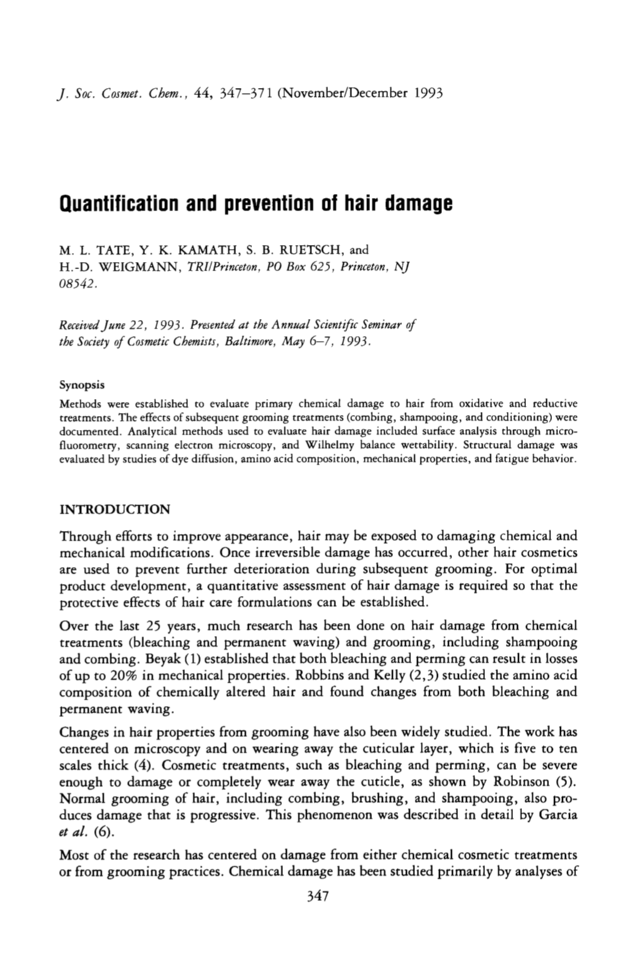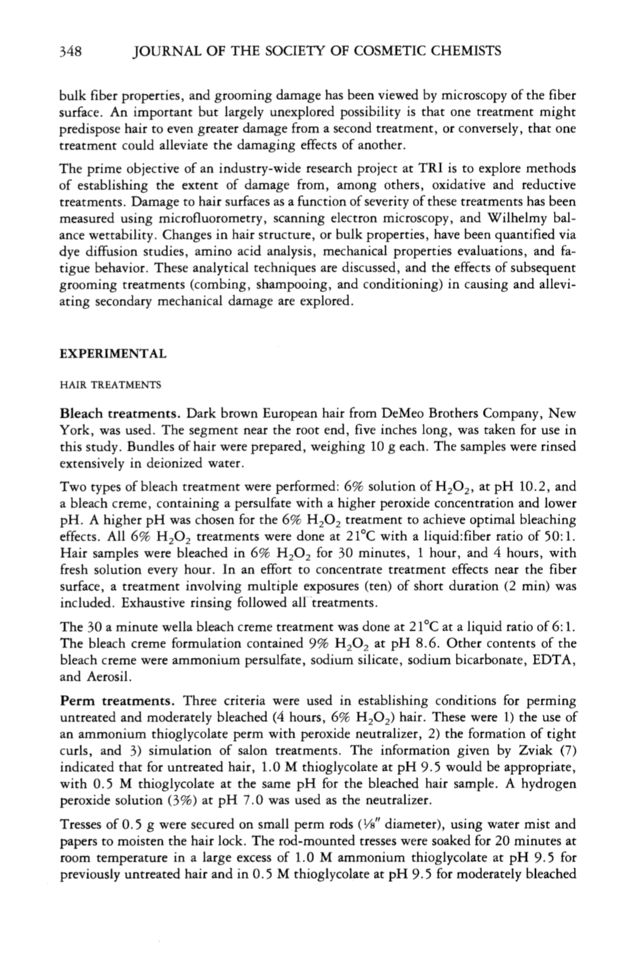j. Soc. Cosmet. Chem., 44, 347-371 (November/December 1993 Quantification and prevention of hair damage M. L. TATE, Y. K. KAMATH, S. B. RUETSCH, and H.-D. WEIGMANN, TRI/Princeton, PO Box 625, Princeton, NJ 08542. Received June 22, 1993. Presented at the Annual Scientific Seminar of the Society of Cosmetic Chemists, Baltimore, May 6-7, 1993. Synopsis Methods were established to evaluate primary chemical damage to hair from oxidative and reductive treatments. The effects of subsequent grooming treatments (combing, shampooing, and conditioning) were documented. Analytical methods used to evaluate hair damage included surface analysis through micro- fluorometry, scanning electron microscopy, and Wilhelmy balance wettability. Structural damage was evaluated by studies of dye diffusion, amino acid composition, mechanical properties, and fatigue behavior. INTRODUCTION Through efforts to improve appearance, hair may be exposed to damaging chemical and mechanical modifications. Once irreversible damage has occurred, other hair cosmetics are used to prevent further deterioration during subsequent grooming. For optimal product development, a quantitative assessment of hair damage is required so that the protective effects of hair care formulations can be established. Over the last 25 years, much research has been done on hair damage from chemical treatments (bleaching and permanent waving) and grooming, including shampooing and combing. Beyak (1) established that both bleaching and perming can result in losses of up to 20% in mechanical properties. Robbins and Kelly (2,3) studied the amino acid composition of chemically altered hair and found changes from both bleaching and permanent waving. Changes in hair properties from grooming have also been widely studied. The work has centered on microscopy and on wearing away the cuticular layer, which is five to ten scales thick (4). Cosmetic treatments, such as bleaching and perming, can be severe enough to damage or completely wear away the cuticle, as shown by Robinson (5). Normal grooming of hair, including combing, brushing, and shampooing, also pro- duces damage that is progressive. This phenomenon was described in detail by Garcia et al. (6). Most of the research has centered on damage from either chemical cosmetic treatments or from grooming practices. Chemical damage has been studied primarily by analyses of 347
348 JOURNAL OF THE SOCIETY OF COSMETIC CHEMISTS bulk fiber properties, and grooming damage has been viewed by microscopy of the fiber surface. An important but largely unexplored possibility is that one treatment might predispose hair to even greater damage from a second treatment, or conversely, that one treatment could alleviate the damaging effects of another. The prime objective of an industry-wide research project at TRI is to explore methods of establishing the extent of damage from, among others, oxidative and reductive treatments. Damage to hair surfaces as a function of severity of these treatments has been measured using microfluorometry, scanning electron microscopy, and Wilhelmy bal- ance wettability. Changes in hair structure, or bulk properties, have been quantified via dye diffusion studies, amino acid analysis, mechanical properties evaluations, and fa- tigue behavior. These analytical techniques are discussed, and the effects of subsequent grooming treatments (combing, shampooing, and conditioning) in causing and allevi- ating secondary mechanical damage are explored. EXPERIMENTAL HAIR TREATMENTS Bleach treatments. Dark brown European hair from DeMeo Brothers Company, New York, was used. The segment near the root end, five inches long, was taken for use in this study. Bundles of hair were prepared, weighing 10 g each. The samples were rinsed extensively in deionized water. Two types of bleach treatment were performed: 6% solution of H202, at pH 10.2, and a bleach creme, containing a persulfate with a higher peroxide concentration and lower pH. A higher pH was chosen for the 6% H202 treatment to achieve optimal bleaching effects. All 6% H202 treatments were done at 21øC with a liquid:fiber ratio of 50:1. Hair samples were bleached in 6% H202 for 30 minutes, 1 hour, and 4 hours, with fresh solution every hour. In an effort to concentrate treatment effects near the fiber surface, a treatment involving multiple exposures (ten) of short duration (2 min) was included. Exhaustive rinsing followed all treatments. The 30 a minute wella bleach creme treatment was done at 2 IøC at a liquid ratio of 6:1. The bleach creme formulation contained 9% H202 at pH 8.6. Other contents of the bleach creme were ammonium persulfate, sodium silicate, sodium bicarbonate, EDTA, and Aerosil. Perm treatments. Three criteria were used in establishing conditions for perming untreated and moderately bleached (4 hours, 6% H202) hair. These were 1) the use of an ammonium thioglycolate perm with peroxide neutralizer, 2) the formation of tight curls, and 3) simulation of salon treatments. The information given by Zviak (7) indicated that for untreated hair, 1.0 M thioglycolate at pH 9.5 would be appropriate, with 0.5 M thioglycolate at the same pH for the bleached hair sample. A hydrogen peroxide solution (3%) at pH 7.0 was used as the neutralizer. Tresses of 0.5 g were secured on small perm rods (¾8" diameter), using water mist and papers to moisten the hair lock. The rod-mounted tresses were soaked for 20 minutes at room temperature in a large excess of 1.0 M ammonium thioglycolate at pH 9.5 for previously untreated hair and in 0.5 M thioglycolate at pH 9.5 for moderately bleached
Purchased for the exclusive use of nofirst nolast (unknown) From: SCC Media Library & Resource Center (library.scconline.org)

















































































